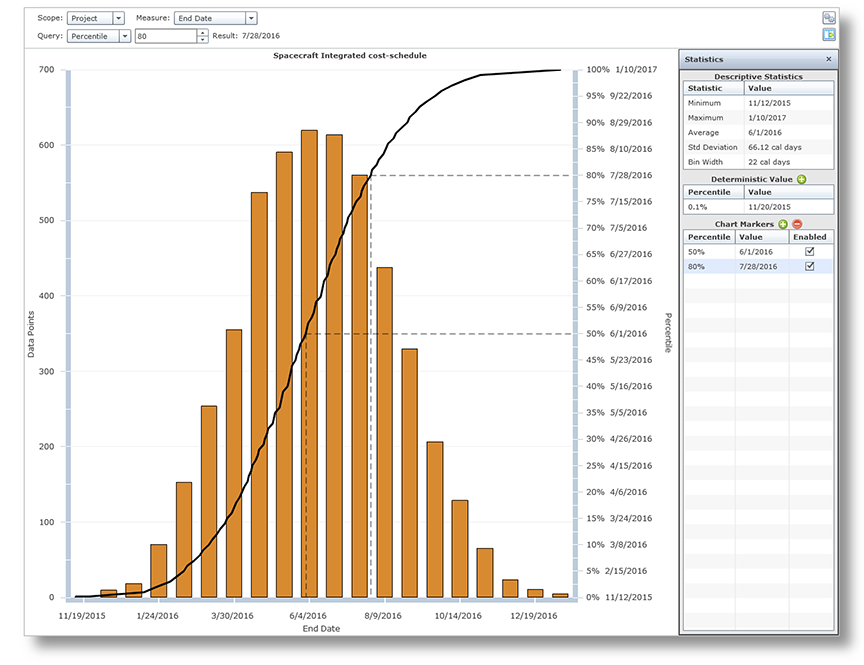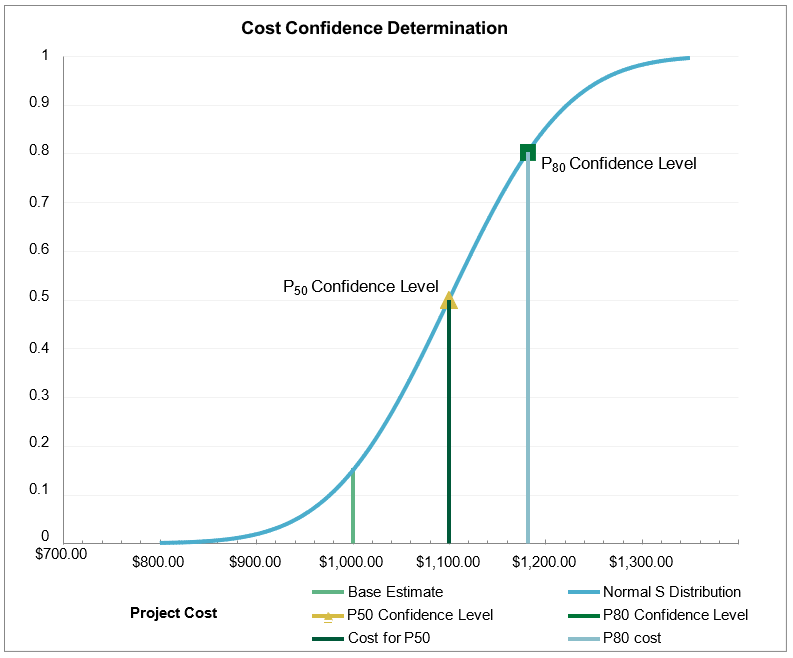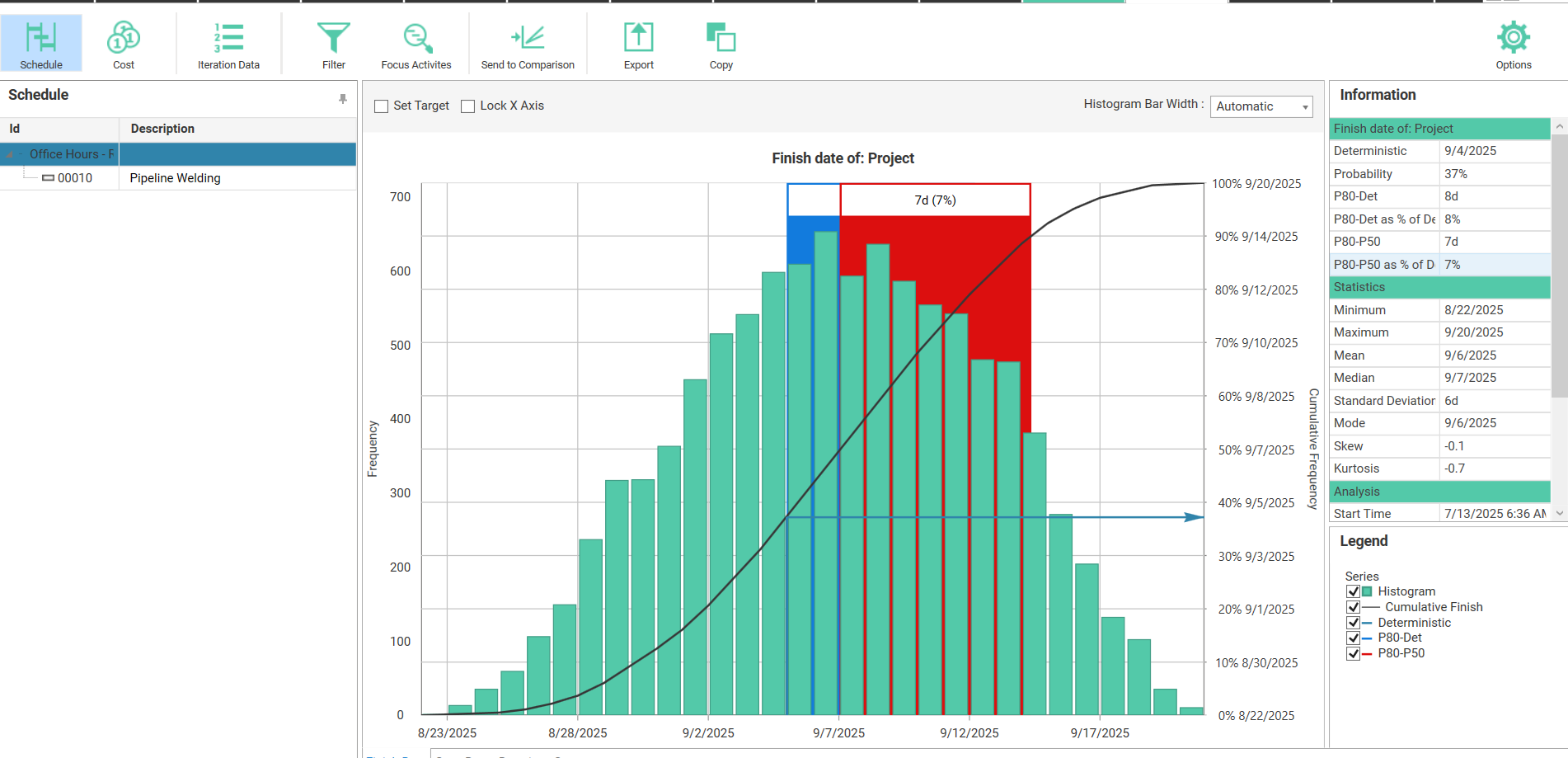Construction schedules rarely go exactly as planned. Weather shifts, late approvals, supply hiccups, and subcontractor performance can quickly turn a confident timeline into a scramble.
Yet many schedules are still built on single-point duration estimates, assuming every activity finishes exactly on time. That’s where Quantitative Schedule Risk Analysis (QSRA) becomes essential.
QSRA applies probabilities and data-driven simulations to your schedule to show how uncertainties will actually impact project completion.
Instead of guessing, you can measure schedule risk, predict realistic finish dates, and understand which activities are most likely to blow up the timeline.
The result? Better contingency planning, stronger negotiation power, fewer surprises, and far more credible communication with owners and stakeholders.
In this guide, we break down QSRA from the ground up, what it is, how it’s done, the tools involved, and why it’s becoming a standard requirement in major construction programs.
Whether you’re a planner, contractor, or client-side PMO, you’ll learn exactly how QSRA turns a baseline schedule into a risk-aware roadmap that protects both deadlines and profit margins.
What is Quantitative Schedule Risk Analysis?
Quantitative Schedule Risk Analysis (QSRA) is a method used in construction project management to measure how risks and uncertainties will affect a project’s timeline. Instead of assuming every task finishes exactly on its planned duration, QSRA assigns probability ranges to activities and runs thousands of simulations to reveal a realistic range of completion dates.
This gives planners and stakeholders visibility into the likelihood of meeting key milestones and the amount of schedule contingency they should carry to protect the finish date.
QSRA also identifies the specific activities and risks that have the greatest potential to delay the project, helping teams focus their mitigation efforts where they matter most.
Because the results are based on statistics rather than subjective judgments, QSRA strengthens negotiations during progress reviews, supports defensible claims when delays occur, and improves decision-making throughout the project lifecycle.
How Quantitative Schedule Risk Analysis Works in Practice
QSRA might sound complex, yet the workflow is straightforward once you see the steps. It connects real project schedules with real risk exposure to show what is actually possible, not what we hope will happen.
The Inputs That Matter
To perform QSRA, you need three main components
- A logic driven schedule with clean relationships and no missing links
- A list of risks that may impact schedule performance
- Three point duration estimates for key activities, optimistic, realistic, and pessimistic
These three points allow the simulation to understand how durations might shift in reality. Procurement packages may take longer than expected. Weather windows might shrink. Approvals may slip. The model captures all that.
Monte Carlo Simulation
Here is where the analysis becomes powerful. The engine tests thousands of schedule outcomes under uncertainty. Each run uses different duration combinations and risk triggers. The output is a full picture of how likely each finish date really is.
The biggest difference from a baseline is simple. A normal schedule gives you one date. QSRA gives a confidence curve that tells you the truth. For example
- Forty percent chance to finish by November
- Sixty percent to finish by December
- Eighty percent to finish by January
This is real risk control. It exposes what could go wrong before it becomes a claim, while clearly showing what needs attention now to protect the finish line.
Why QSRA Is Essential for Contractors and Consultants

Construction is full of uncertainty. What QSRA does is transform that uncertainty into measurable, defensible intelligence. It shifts teams from reacting to problems to anticipating them.
The Strategic Benefits
- Better negotiation with owners, supported by data not instinct
- Transparent reporting, everyone sees the same reality
- Contingency that is justified and properly allocated
- Performance monitoring against confidence based milestones
Owners appreciate QSRA because it prevents surprises. Contractors appreciate it because it provides evidence. When delays happen, QSRA results help demonstrate which risks were unavoidable and which were already identified. This becomes critical in determining entitlement for time extensions.
Protecting Profitability
A late project means extra staff, extended preliminaries, liquidated damages and damaged reputation. QSRA flags the financial consequences of slippage early enough that teams can still intervene. It highlights the top risk drivers, the activities that deserve the most attention and mitigation.
In short, QSRA improves trust and reduces disputes. It proves who managed the schedule responsibly and who did not. It is not only a risk tool, it is a claims defense shield and a credibility booster for project teams.
The Tools Used for QSRA and How They Connect to Primavera

Primavera P6 is the backbone of many project schedules. QSRA builds on top of it. Think of it like this
P6 creates the plan, while QSRA validates whether that plan is actually achievable.
How They Work Together
- The baseline schedule is developed and maintained in Primavera
- The schedule is exported to a risk analysis tool
- Risk events and duration uncertainties are added
- Simulations run to reveal the confidence level for completion
Common Tools Used With Primavera
- Deltek Acumen Risk
- Oracle Primavera Risk Analysis
- Safran Risk
- Schedule Analyzer platforms that support quantitative modeling
These tools plug into the schedule and generate charts such as confidence curves and tornado diagrams. They also allow scenario planning, what if the steel package arrives late, what if approvals take three weeks longer. With this capability, planners become proactive. They make decisions before delays crystallize.
Software alone is not enough though. The strength of QSRA depends on the maturity of the schedule. Clean logic, realistic sequencing and accurate durations are the foundation. When those are strong, QSRA gives unmatched clarity that a static baseline simply cannot deliver.
Understanding Confidence Levels: P50, P70, P80 and What They Mean for Decisions


QSRA outputs are often summarized using confidence levels. These show how likely it is to achieve a specific completion date. Instead of giving stakeholders a single promise, planners present a set of outcomes backed by probability.
The Most Common Confidence Points
- P50: A fifty percent chance to meet the date
- P70: A seventy percent chance
- P80: An eighty percent chance or stronger
A P50 finish date is technically possible, yet risky. A P80 finish date is safer but may require longer delivery. Stakeholders choose which point to adopt depending on project complexity, contract conditions, and risk appetite.
Why It Matters in Real Conversations
Imagine your project has a baseline finish by December 10. QSRA results might show
- Only a forty percent chance to finish by that date
- A seventy percent chance to finish by January 5
- An eighty percent chance to finish by January 25
Now the question becomes a leadership decision
Do we hold to December and invest in mitigation
Or do we realign expectations based on modeled reality
Without QSRA, this discussion would be guesswork. Confidence levels turn it into strategic planning.
Common Mistakes That Make QSRA Results Misleading
Even the best simulation tools cannot fix a weak foundation. QSRA is extremely sensitive to schedule quality. When the inputs are flawed, the outputs can be dangerously deceptive.
Frequent Issues
- Missing links and forced dates that break logic
- High float paths that are artificial, not realistic
- Underestimated durations driven by optimistic planning
- Risk registers focused only on commercial, not schedule threats
- Activity uncertainty added without proper calibration
When risk data is poorly aligned with real project behavior, QSRA becomes noise instead of insight. Results may look impressive as reports, yet fail to prevent delays in practice.
What Good Teams Do
They clean schedules continually. They validate risk exposure with site teams. They ensure updates reflect the truth happening on ground conditions. QSRA is not a one time study. It is a continuous discipline that matures over project stages.
The rule is simple.
If the schedule is wrong, QSRA tells the wrong story.
A Step by Step QSRA Workflow Any Team Can Follow

QSRA does not need to be mysterious. Here is a practical workflow you can use on any medium to large construction project.
The Six Essential Steps
- Build a schedule with solid logic, no gaps, and no arbitrary constraints
- Identify schedule sensitive risks through workshops and expert judgment
- Assign three point duration estimates to key activities
- Map risks to affected activities and quantify their impact
- Run Monte Carlo simulation with sufficient iterations
- Review the results and update mitigation plans accordingly
What to Look For in Outputs
- Confidence curves and historic trend shifts over time
- Tornado charts showing the top delay drivers
- Critical path evolution during risk impact
- Contingency required for each milestone
QSRA is not about creating fear. It is about providing clarity. The earlier these steps begin, the lower the cost of controlling the timeline. This is how professional project teams avoid firefighting and instead maintain strategic command of progress.
How QSRA Supports Delay Claims and Contractual Entitlement

Delays happen. The real battlefield becomes who owns the delay. QSRA prepares your defense long before disputes escalate.
What QSRA Proves
- Which risks were identified early and transparently
- That delays arose from already acknowledged threats
- That contractors acted responsibly by planning contingencies
- Clear causation between risk events and delay impact
This is powerful in Extensions of Time submissions because it combines factual status updates with probability based justification. Owners trust what they can verify. QSRA makes entitlement clearer, faster, and more professional.
Strength in Negotiation
Contractors who perform QSRA regularly demonstrate
Responsibility
Preparedness
Control over their schedule
When risk turns into delay, QSRA provides the storyline and evidence that supports fair outcomes instead of costly disputes.
Bringing It All Together With Opteam AI
Your Company’s Progress Reality, Made Visible
In most companies, QSRA is extremely difficult to maintain because progress data is slow and outdated. Reports take days to compile. Risk exposure changes while teams are still calculating last week’s status.
That is exactly where Opteam transforms the entire process.
What Opteam Enables Instantly
- Upload your project files
- Connect site teams through automated communications
- Get live schedule insights and reporting without manual work
Opteam gives you the truth of your project status every day, not once a month. With that, QSRA becomes a real time strategic engine rather than a one off consultant exercise.
The future of construction scheduling is simple.
Your data updates itself. Your AI calculates the rest.
Take control back today.
👉 Create your free Opteam account now and see your project’s reality within minutes
https://app.opteam.ai/signup


